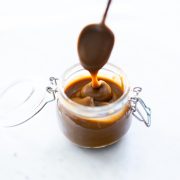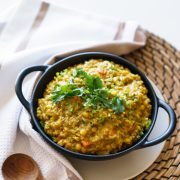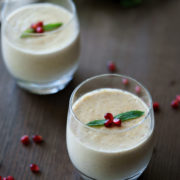Vegan Caramel
Can you really make a delicious vegan caramel without dairy? Well, of course you can! Read on to find out more.

Firstly, a little life update – scroll down to get straight to the recipe.
People, I cannot believe it’s been months since my last blogpost. Between getting ready for the baby and organising things at work, I was left with very little time (and energy) to do anything else. I figured that I would have a ton of time during my maternity leave to catch up on things (doesn’t baby sleep all the time?). But as it turns out, while it is true that baby sleeps a lot, baby also feeds nonstop, pees like a drunken teenager, and cries in between sleeping and peeing. And baby’s preferred bed to sleep is – on mummy’s chest.

Today my baby is one month old. One month down, hundreds more to go. She’s slowly getting used to being a human and I’m slowly getting used to being a mum – nothing can ever prepare you for both. I’m acclimatising to the new routine and the inevitable sleep deprivation and now I’m able to squeeze in a bit of creative work in between feeding and changing nappies. Life as a new mother is hard – I don’t get much sleep, I have carpal tunnel syndrome in my hands from breastfeeding and my shoulder is sore all the time from carrying the baby around. That aside, I am doing well, and the baby is growing like a champ. Enough about me, it’s time to make some caramel.

What I love about this recipe
Just five ingredients and minimal cooking effort for a sweet reward. What’s not to love? This recipe is coconut heavy so if you’re not a fan of coconut then it might not be for you. However, once cooked I find that it tastes less coconutty and more caramelly, so don’t dismiss it too quickly, you might still be pleasantly surprised.

It’s dairy-free and it tastes legitimately like caramel. The fleur de sel adds that extra depth of flavour but if you don’t have it, you can replace it with good quality sea salt. Texture-wise it is not a sticky caramel but a creamy one.
Make it, spread it, drizzle it, spoon it. This is what love tastes like.

Vegan caramel

Delicious, rich and creamy dairy-free caramel
- 400 ml coconut milk
- 1 tbsp coconut oil
- 1/2 cup coconut sugar
- 1/2 tsp fleur de sel (optional – can be replaced with sea salt)
- 1 tsp vanilla extract
- Add all ingredients into a saucepan
- Bring to boil on medium heat then reduce the heat to low simmer for 30 min, stirring every 10 min
- Watch for the next 10 min while it thickens and turn dark brown, stirring frequently.
- The caramel is ready when it covers the back of a wooden spoon. Turn off the heat and let cool before serving.
Store in an airtight container in the fridge for about two weeks.
P.S. If you make this, I’d love to hear from you. Leave a comment below or find me on Instagram or Facebook. Don’t forget to tag me @passionatelykeren so I won’t miss your post.
Keren x








































